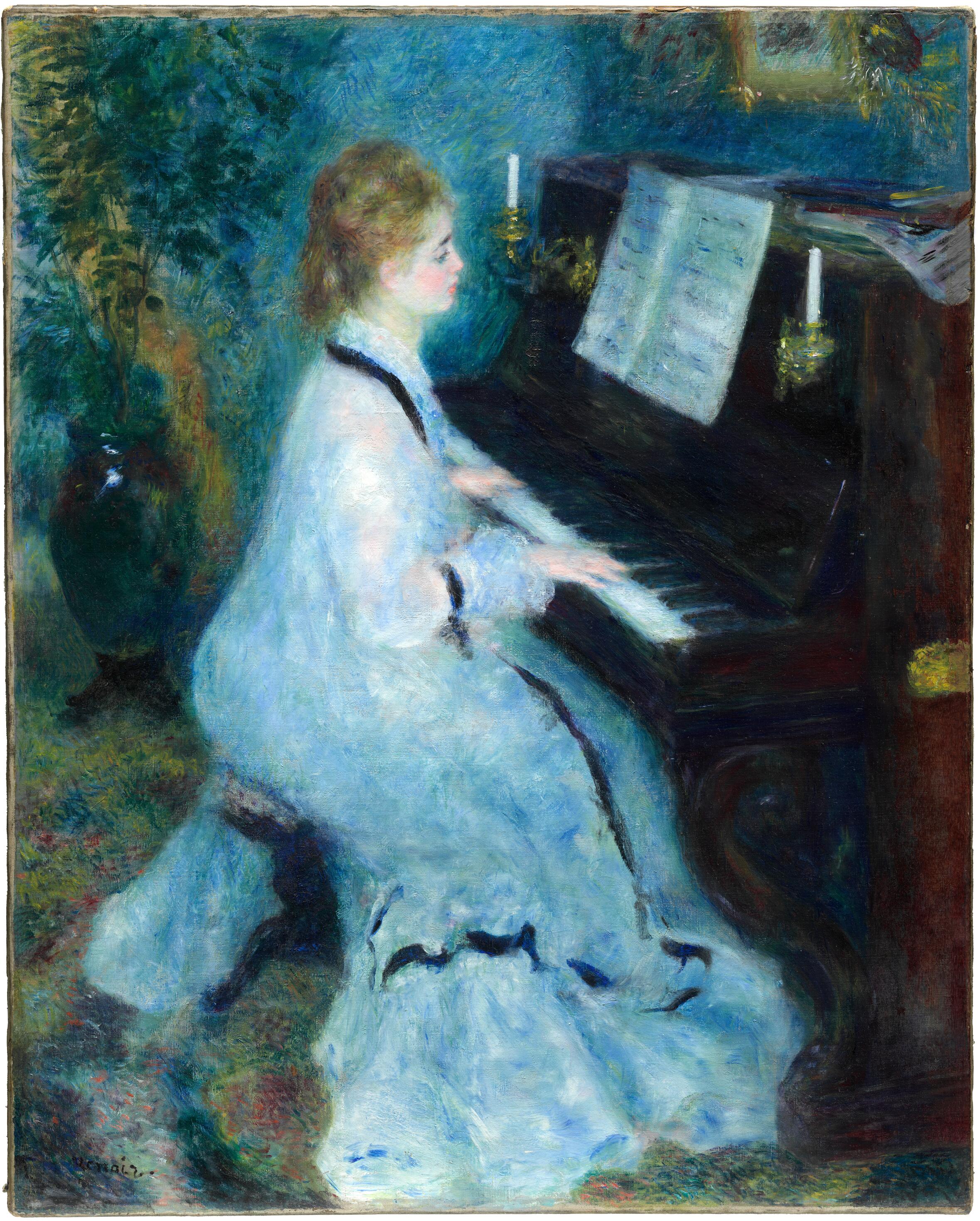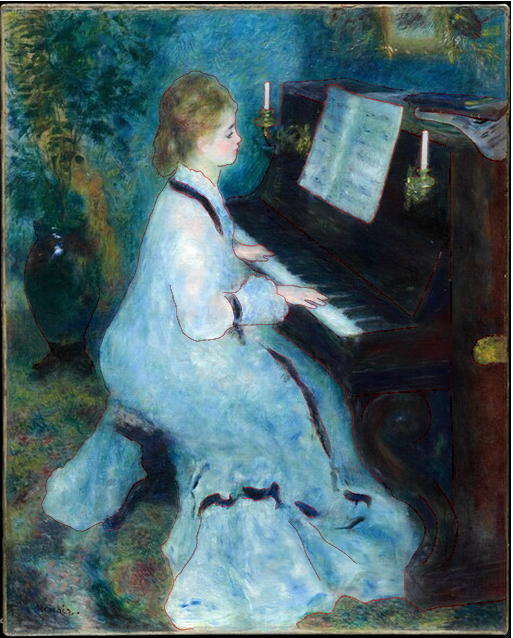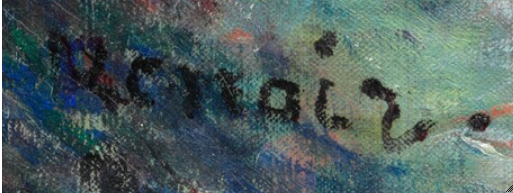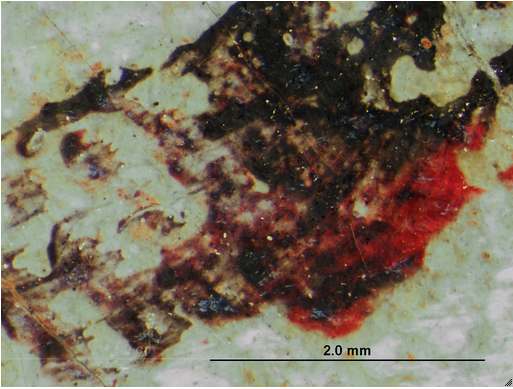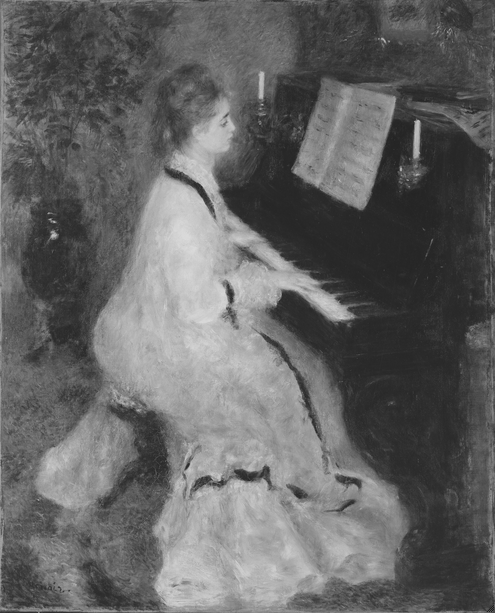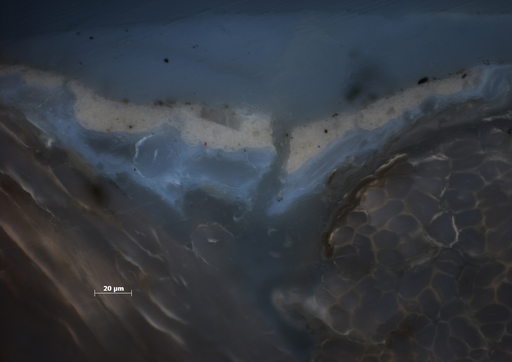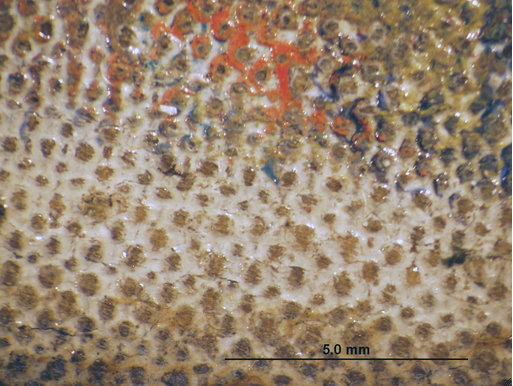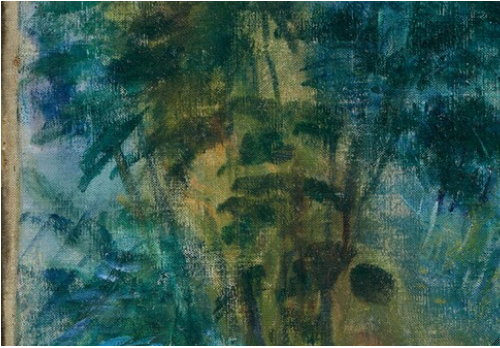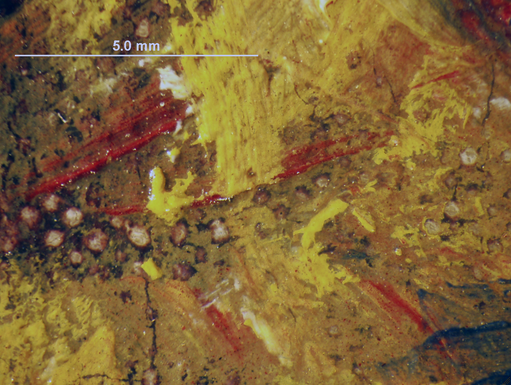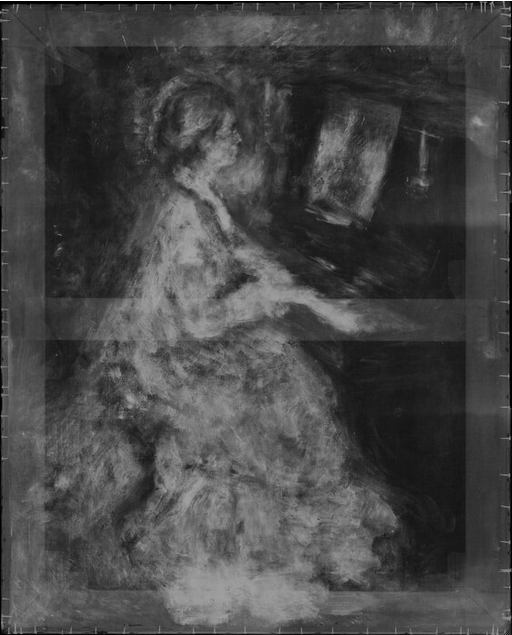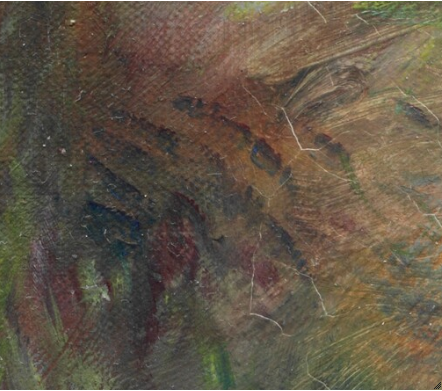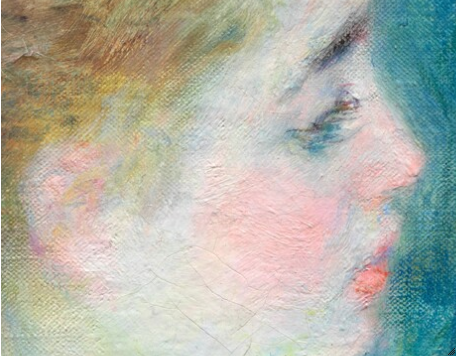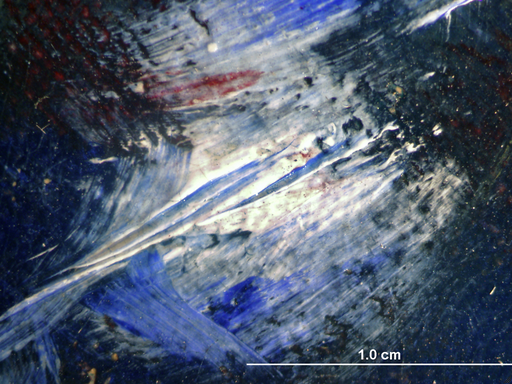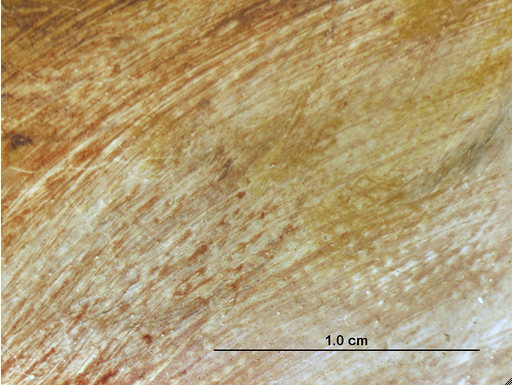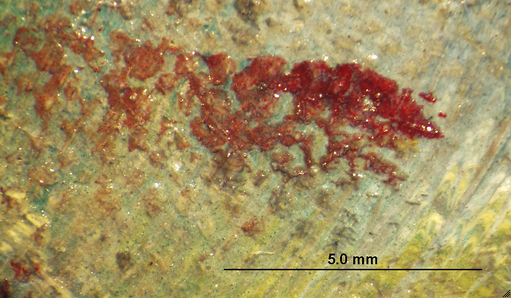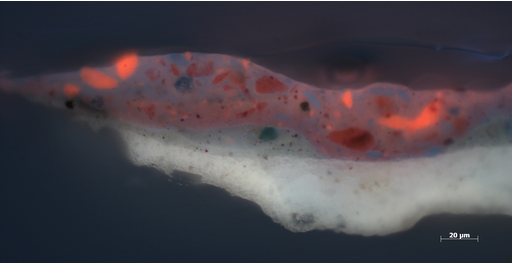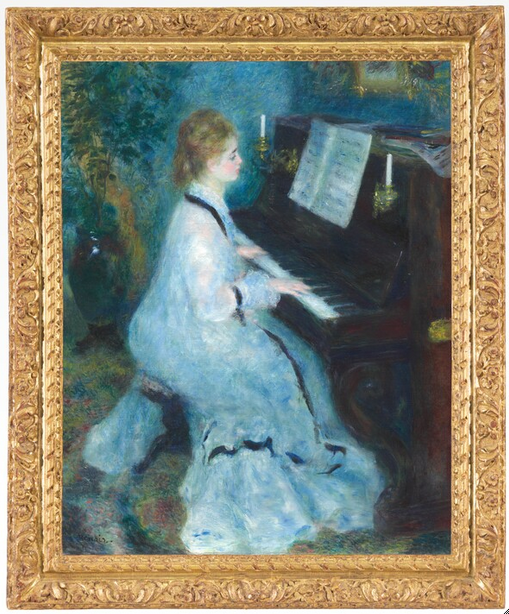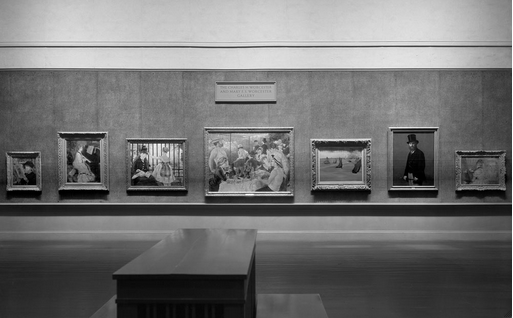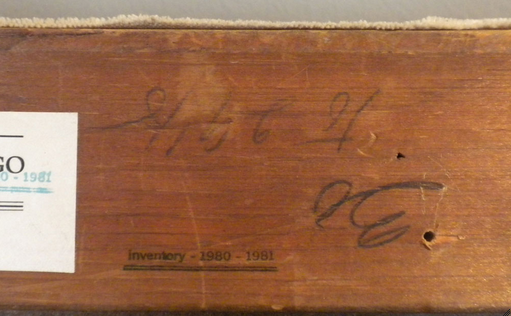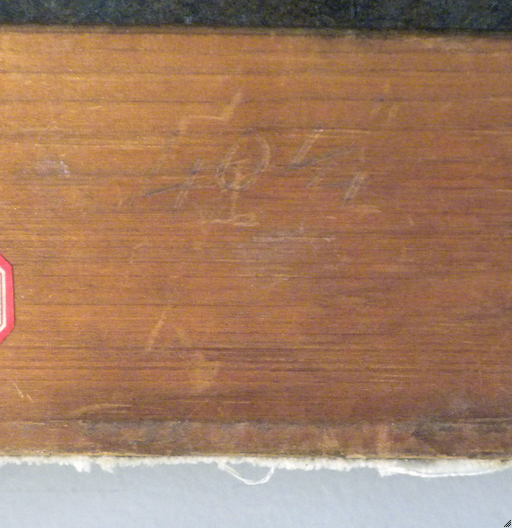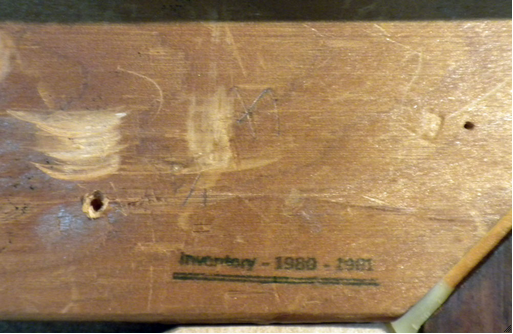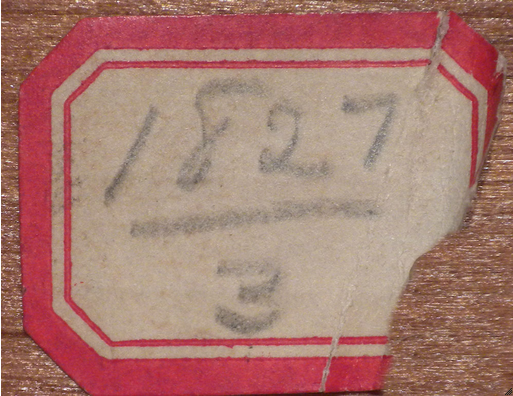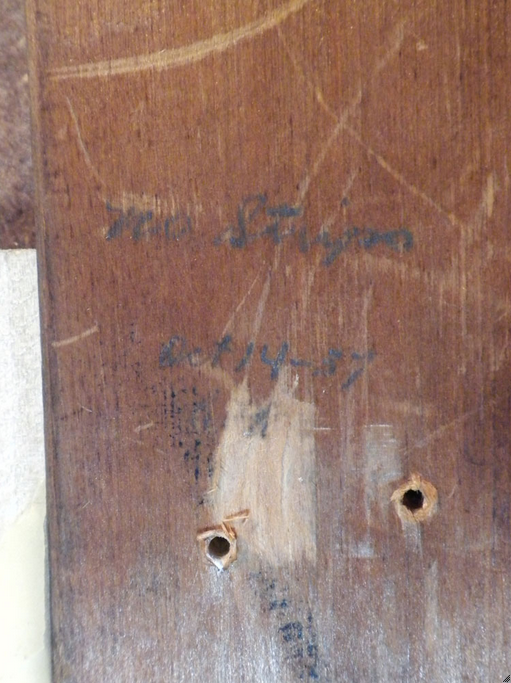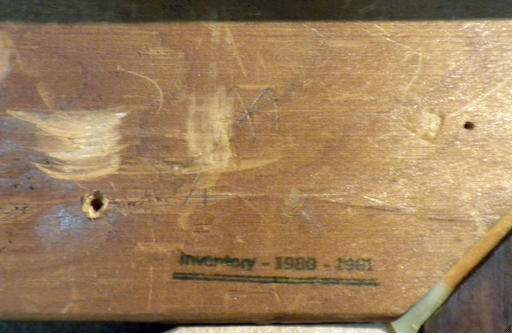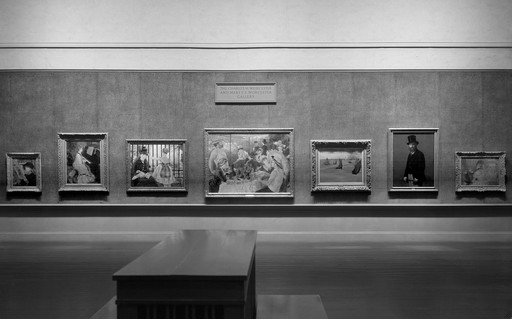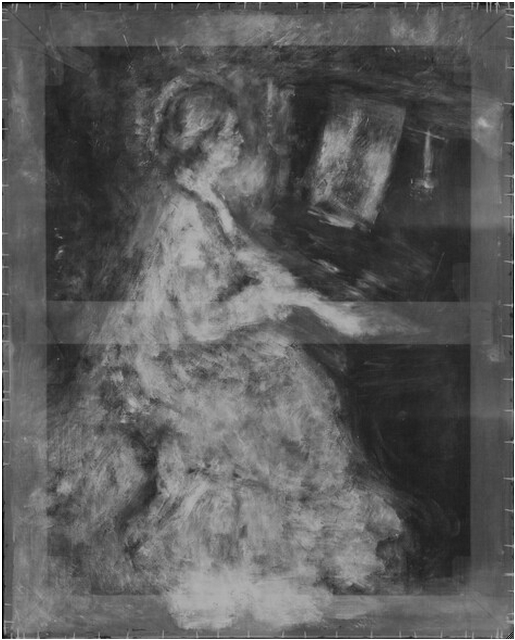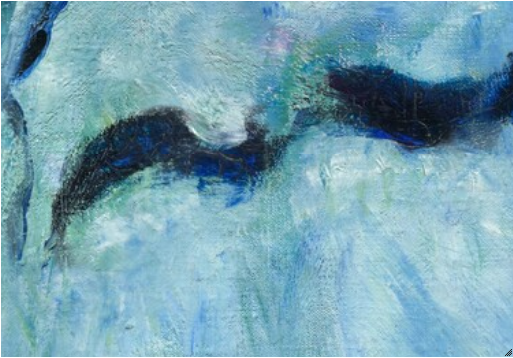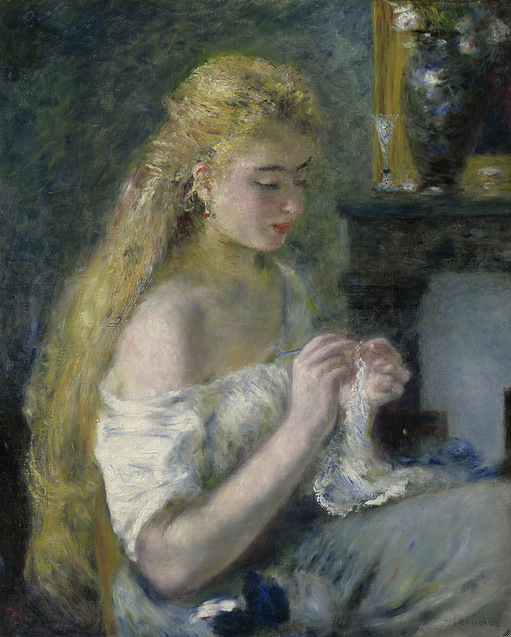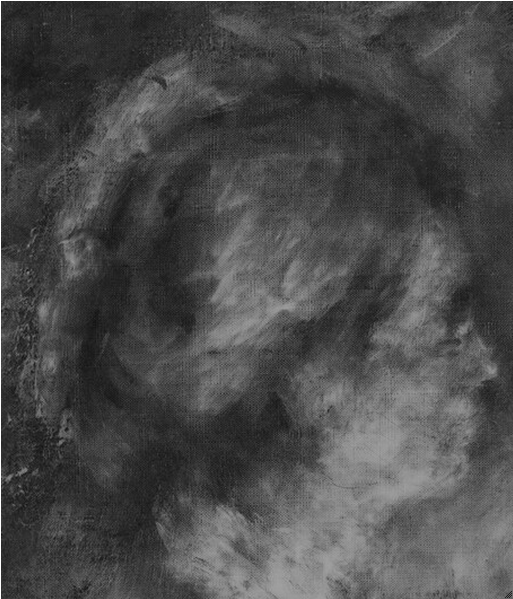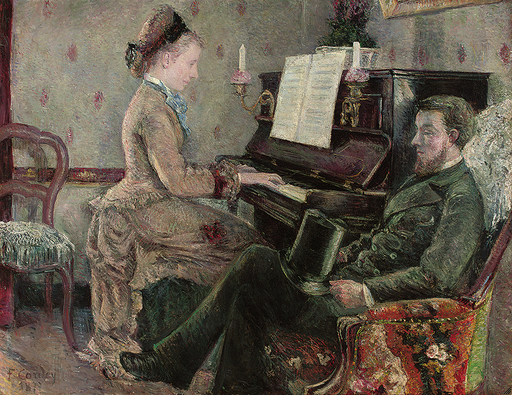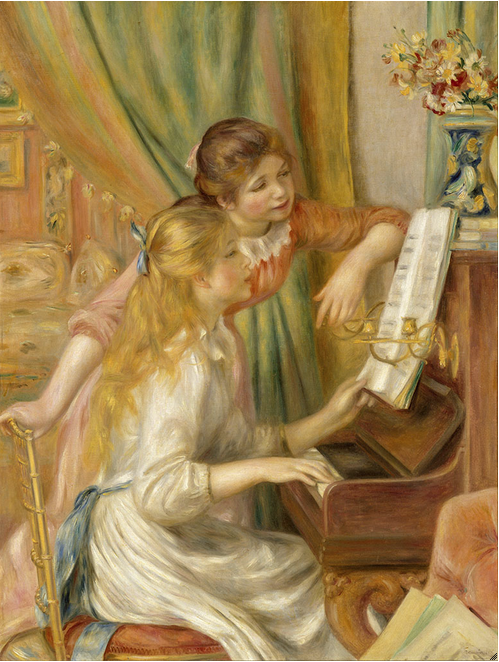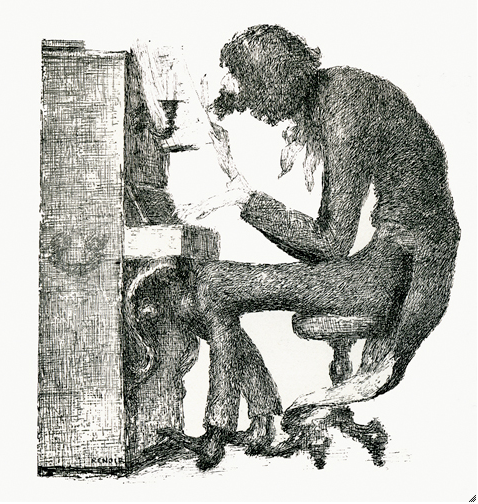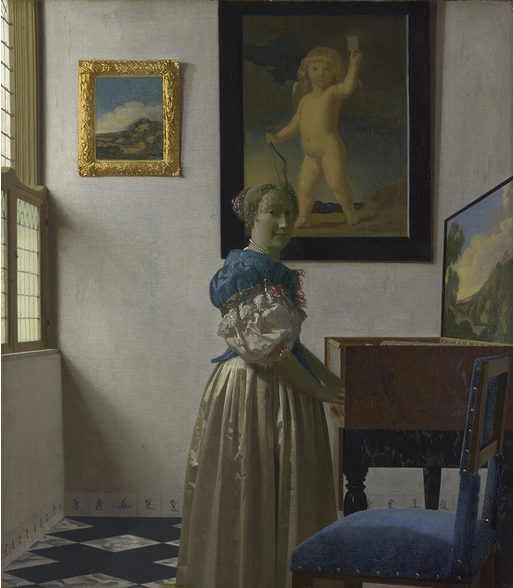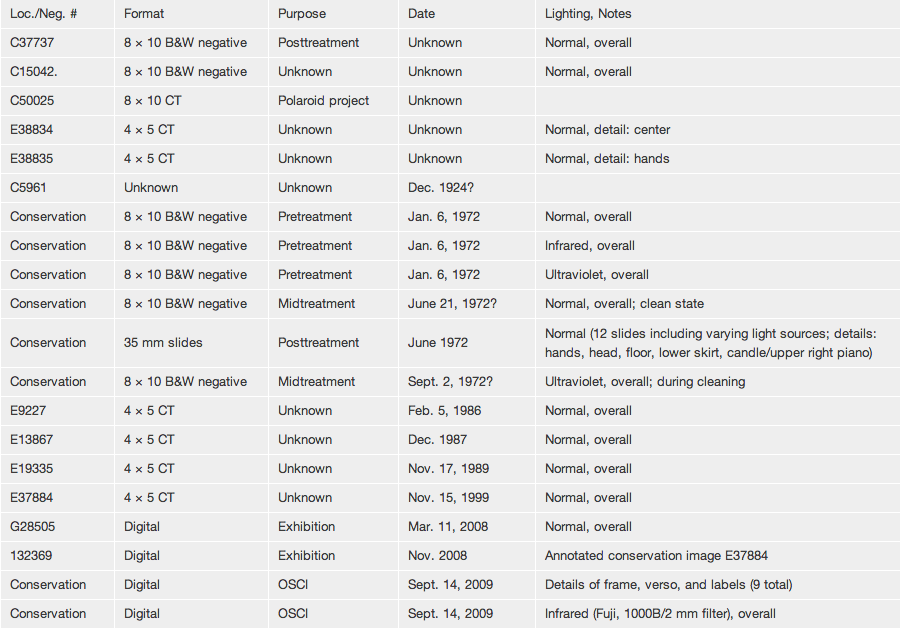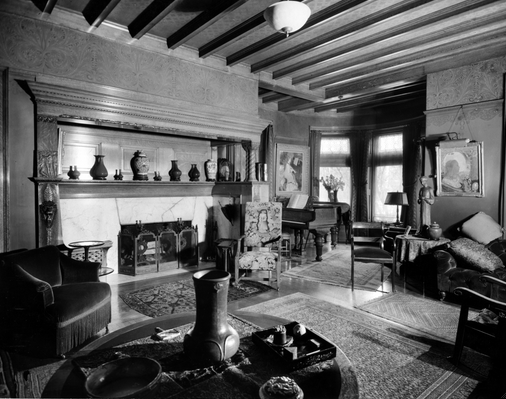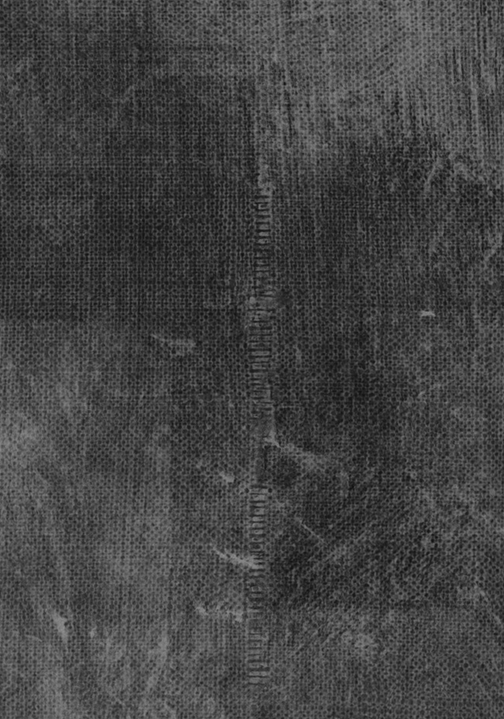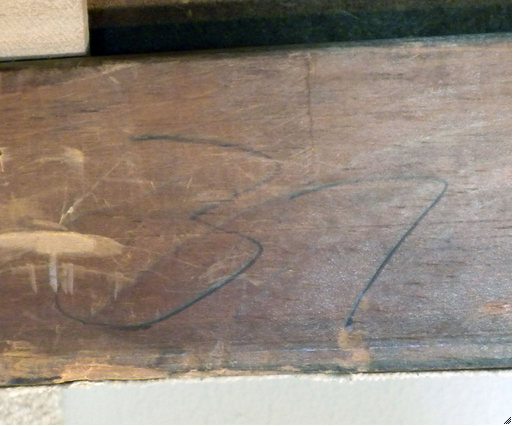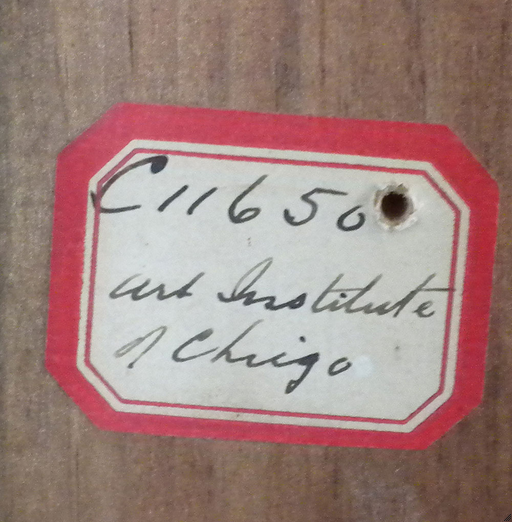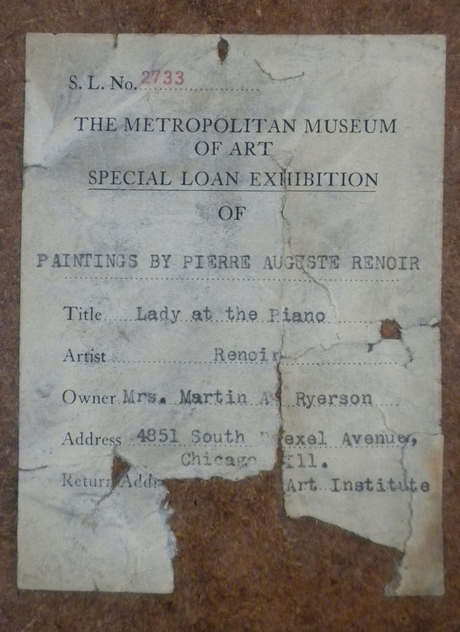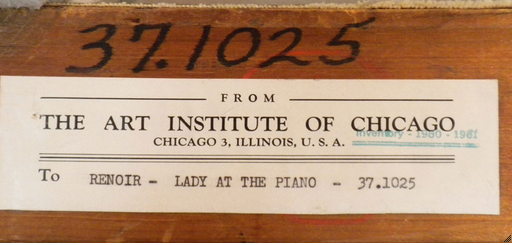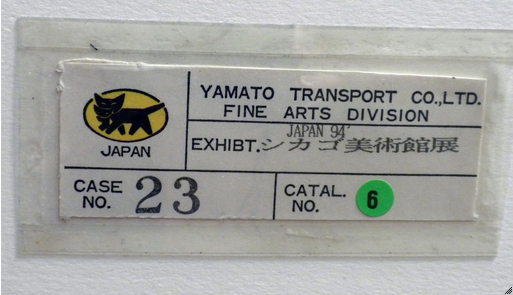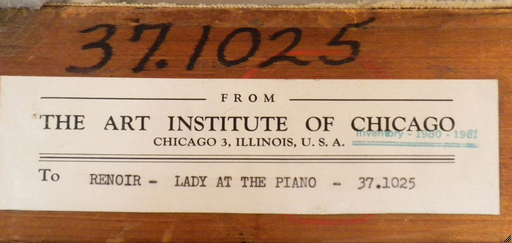Technical Report
Technical Summary
Renoir began with a commercially primed canvas and roughly separated broad areas of the compositional space with thin layers of opaque paint; a thin, dark-red wash was used to define the piano on the right. This dark red extends past the apparent foldover edge and may indicate that the artist began his composition on an unstretched canvas or on a canvas on a slightly larger, nonstandard stretcher that he later moved to a smaller stretcher. With a relatively limited palette, Renoir created textural differences by manipulating the paint in many ways, including thin washes, scraping, thick impasto, wet-in-wet modeling, and dragging a stiff brush across wet paint. X-radiography indicates compositional changes to both the figure and the piano. Renoir established the initial forms of these elements and brought the background in around them before making subsequent changes to the composition. He altered the figure’s pose—originally in profile, in the final composition she is turned slightly toward the viewer—as well as her dress and hairstyle. After executing the figure in her initial form, Renoir slimmed her overall silhouette and greatly diminished the volume of her skirt. Her hair was altered from a simple, downswept roll to an upswept style with added volume at the crown. The piano was widened, perhaps painted from a different perspective. Initially the overall profile of the piano was more foreshortened, projecting farther into space; however, the top of the piano was slightly less foreshortened, signaling a change in vantage not only farther to the left with respect to the subject, but perhaps also slightly lower. Once the figure and the piano were executed in their final forms, the artist smoothed the transition between figure and ground with a combination of wet-in-wet modeling and working thin, translucent layers over dry paint.
Multilayer Interactive Image Viewer
The multilayer interactive image viewer is designed to facilitate the viewer’s exploration and comparison of the technical images (fig. 3.10).
Signature
Signed: Renoir. (lower left, in warm-black paint) (fig. 3.11, fig. 3.12).
Structure and Technique
Support
Canvas
Flax (commonly known as linen).
Standard format
Measuring from a ridge around the perimeter that appears to be a flattened foldover, the original dimensions appear to be approximately 91.5 × 73 cm; cusping visible in the X-ray corresponds to tack placement for this size. This most likely corresponds to a no. 30 portrait (figure) standard-size (92 × 73 cm) canvas.
Determining the original size of the canvas is complicated by many factors, as the dimensions may have been changed by the artist and the original foldover edge does not appear to be a straight line. Additional canvas was left exposed around the perimeter when the painting was lined, and during the same treatment it was mounted slightly askew.
Aspects of the painting’s construction suggest that Renoir may have changed the size of the canvas himself after beginning his composition off the stretcher or stretched to a larger secondary support. The work features uneven edges on all sides, the straightest of which appears to be the left. Folding the painting at the apparent foldover on the right would also make it correspond to a no. 30 portrait (figure) standard-size canvas; some sense of the original dimensions and the nature of the original edges are more apparent in clean-state photos from the 1972 treatment (fig. 3.13). The artist appears to have lined up the painting for stretching on a standard stretcher by the left side, folding over a small portion of the scraped-back, dark-red piano paint (fig. 3.14). After numerous compositional changes, small margins of background paint on the lower left and upper right were likely added by Renoir to square the composition to fit a standard size.
Weave
Plain weave. Average thread count (standard deviation): 22.4V (0.8) × 26.1H (0.5) threads/cm. The horizontal threads were determined to correspond to the warp and the vertical threads to the weft.
Canvas characteristics
The canvas has mild cusping on the top, bottom, and left edges, corresponding to the placement of the original tacks. On the right, cusping corresponds to the inner set of tack holes (visible along the foldover edge) rather than to the secondary set of tack holes on the current tacking margin (fig. 3.15). There is a double thread fault on the lower left (fig. 3.16).
Stretching
Current stretching: When the painting was lined in 1937, it was placed slightly askew, and the original dimensions were increased on all sides by up to 1 cm. It is possible that the right margin was also extended as part of this treatment (see Conservation History).
Original stretching: Based on cusping visible in the X-ray, the original tacks were placed approximately 3.5–7 cm apart.
Stretcher/strainer
Current stretcher: Five-member keyable stretcher with a horizontal crossbar. This stretcher is not believed to be original to the painting and probably dates from the 1937 treatment (see Conservation History).
Original stretcher: Unknown.
Manufacturer’s/supplier’s marks
No manufacturer’s or supplier’s marks were observed during the current examination or documented in previous examinations.
Preparatory Layers
Sizing
Cross-sectional analysis indicates a thin, brownish layer of material between the canvas and the ground that closely follows the canvas texture. This material is organic, based on its characteristic bluish fluorescence in UV light, and is estimated to be glue (fig. 3.17).
Ground application/texture
There is a smooth, single-layer, commercially applied ground, approximately 10–40 µm thick, that extends to the edges of the tacking margins (fig. 3.18).
Color
The ground appears to be warm white, with dark particles visible under stereomicroscopic examination (fig. 3.19). Small percentages of black and iron oxide yellow and red were found in cross-sectional analysis and contribute to this warm appearance. This layer is porous and has darkened over time due to the combined effects of accumulated grime and saturation by the wax-resin lining material (see Conservation History and Condition Summary).
Materials/composition
The ground is predominantly lead white, with small amounts of calcium-based white, iron oxide yellow and red (and associated silicates), and traces of bone black, complex silicates, and barium sulfate extenders. The binder is estimated to be oil.
Compositional Planning/Underdrawing/Painted Sketch
Extent/character
No underdrawing was observed with infrared reflectography or under stereomicroscopic examination.
Paint Layer
Application/technique and artist’s revisions
Renoir began the painting by laying in localized colors, some in opaque layers, and loosely defining various areas of the composition. On the upper left and across much of the top, a bright-white underlayer serves to visually brighten the top half of the painting (fig. 3.20). Underneath the figure and foreground, however, the underlayers appear thick and beige, a color very similar to that of the ground. It is unclear whether this beige layer was intended to function like the white in the top half of the composition or was used to cover previous compositional choices in certain areas. Comparatively wide strokes (up to 3 cm wide) of this warm beige are seen in raking-light and X-ray images throughout the left foreground rug, on either side of the dress (fig. 3.21).
On the right, the artist used a dark-red wash for the piano that extends past the apparent original foldover edge. The paint along this edge is very thin, appears scraped back and abraded, and includes only the lower layers of paint and none of the upper details of the gold ornament on the side of the piano or the music books on top of the piano. It is possible that Renoir began the work off the stretcher or on a larger, nonstandard stretcher and later shortened it to correspond to a standard-size stretcher. The paint layers present on the far right edge suggest that this change was made before the upper layers of the piano were added. The artist scraped back the paint along the right side and may have changed the size of the work before changing the angle of the piano and adding details such as the gold decorative ornament and the sheet music (fig. 3.22). Once the work was stretched, he “squared” the composition on the upper right and lower left with additional background paint. As these areas lack the previously mentioned opaque underpaints that define their surroundings, they appear quite different in color and texture than the rest of the canvas, but they do appear to be original.
Renoir made substantial changes to both the figure and the piano in this composition. The X-ray indicates that the piano originally appeared thinner and taller. The top of the piano was painted from a slightly downward perspective, with more of the surface visible and featuring additional sheet music and a curved decorative element. The top now appears more foreshortened, and the overall profile of the piano is wider and angled more toward the viewer (fig. 3.15). The sheet music just above the keyboard appears longer and curved in the X-ray, possibly indicating turning or buckling pages, and a radio-opaque form just under the music suggests that a music ledge was articulated at this stage. The X-ray also suggests that the artist raised the position of the candlesticks and altered the curve along the side and legs of the piano in the foreground.
Renoir made numerous changes to the figure’s hairstyle, dress, and profile. Originally her hair, swept down smoothly along the side of her head, was tucked back in a simple roll. Brushstrokes in the hair indicate that the artist simply layered thin strokes in a different direction over the previous arrangement to suggest a more upswept style with added volume at the crown (fig. 3.23). Traction cracking in this area resulted from the thinness of these layers compared to the heavier paint underneath, a trait also visible in raking light. In the X-ray, the figure’s dress appears more voluminous, bowing out around the knees and coming in atop a larger ruffled bottom. The skirt seems to bend in on itself, and the piano seat is almost entirely hidden by it. A radio-transparent band along this inward fold of the skirt indicates that it was originally higher than it appears in the visible composition. In the final arrangement, Renoir reduced the volume of the skirt on both sides of the piano seat, revealing more of the seat and cushion and giving definition to the bottom half of the figure. The artist slimmed her overall silhouette, straightened her neck, and brought up her neck and chin slightly to suggest a more upright posture. The figure appears in full profile, with her head angled more toward the viewer. To accomplish this, Renoir moved her forehead, chin, eyes, and hairline slightly to the left with respect to her nose (fig. 3.24). A visible buildup of the paint in the flesh tones, where the artist subtly altered the head, can be seen in raking light. The figure’s arms remain in the same position in the X-ray and the final composition, but her left hand was moved farther back in space, and paint revealed by cracking in this area indicates that the ruffle at the cuff of her sleeve was probably extended after the wrist was executed (fig. 3.25). Similar cracks also reveal that the artist added flesh tones over the white of the sleeve to create the illusion of a translucent garment.
Renoir established both the female figure and the piano before bringing in the background. In the X-ray, heavy strokes of background paint come up to and around these elements; this is especially noticeable around the figure’s head, where a kind of radio-opaque halo is visible. After the artist settled on the final composition, he softened the transition between figure and ground with additional background paint applied either wet-in-wet or in thin, translucent layers over dry paint.
Renoir’s paint application varies in thickness and texture, from washes and areas scraped with a palette knife, to heavy impasto and visible brushwork (fig. 3.26). The artist mixed many hues directly on the surface of the painting, working wet-in-wet to varying degrees to produce smooth blending, as seen in the figure’s dress and flesh (fig. 3.27). In some areas, short strokes of color or highlights pick up a small amount of the surrounding paint, as on the vase on the left (fig. 3.28). To create the illusion of individual strands of hair framing the figure’s face, Renoir dragged a stiff brush across wet paint, allowing the bristles to cut through and reveal the light underpaint (fig. 3.29). The artist also added details in very dry paint, dragging his brush across the surface, as in the foliage, highlights on the candlesticks, parts of the vase, and upper details of the foreground rug (fig. 3.30).
Painting tools
Soft- and stiff-bristle brushes (strokes up to 1 cm wide); palette knife for scraping; possible wider brushes (strokes about 3 cm wide) used in the foreground underlayers.
Palette
Analysis indicates the presence of the following pigments: lead white, zinc white, cobalt blue, cerulean blue, emerald green, viridian, chrome yellow, zinc yellow, bone black, vermilion, madder lake, carmine lake, iron oxide red, and red lead.
Analysis suggests that the paint mixtures vary in their complexity, with some simpler mixtures of two or three pigments and other more complex combinations. The flesh tones, for example, contain lead white, vermilion, and red lake. The dark-blue ribbon running through the lower portion of the figure’s dress, however, is more complex; in addition to cobalt blue, there is some cerulean blue and chrome yellow, with traces of bone black, zinc yellow, and possibly red lake. The observation of a characteristic bright orange fluorescence under UV light indicates that the artist used a fluorescing red lake in the flesh tones, parts of the front of the piano, and the figure’s hair (fig. 3.31). It is likely that Renoir used a different red lake for the main body of the piano. Cross-sectional analysis of a sample from the piano indicates that the artist mixed both lakes; in UV light, the fluorescing and nonfluorescing red lakes are visible side by side (fig. 3.32).
Binding media
Oil (estimated).
Surface Finish
Varnish layer/media
The current synthetic varnish was applied in 1972, replacing a natural-resin varnish. It is unclear whether the natural-resin varnish dates from the 1937 lining or from a proposed 1940 treatment (see Conservation History).
Conservation History
The painting was treated by Chicago private conservator Leo Marzolo just before it was acquired by the Art Institute in 1937. Treatment at this time included wax-resin lining to a secondary canvas and mounting the lined canvas onto Masonite before restretching the entire structure on a five-member keyable stretcher. The painting was minimally scratched in transit in 1940 and repaired in November of the same year by Marzolo. The examination report for this treatment confirmed that the work was already wax-resin lined, “then placed onto Masonite.” This record also indicated dissatisfaction with the surface coating and recommended removing the excess wax and replacing it with a wax-damar-mastic mixture. As there is no further documentation, both the specific nature of the previous coating and whether this treatment was completed remain unclear.
The work was superficially treated in 1969, including grime removal with detergent water, thinning of the surface coating, toning of discolored retouching, and resaturation of the surface with three coats of synthetic varnish (an isolating layer of polyvinyl acetate [PVA] AYAA, followed by methacrylate resin L-46, and a final coat of AYAA). The painting was treated again in 1972 in preparation for exhibition. An aged natural-resin varnish and extensive retouching along the edges were removed, along with the 1969 synthetic varnish system, at this time with a combination of solvent and mechanical cleaning. The painting was again given a three-layer varnish (an isolating layer of polyvinyl acetate [PVA] AYAA, followed by methacrylate resin L-46, and a final coat of AYAA) and retouched. Heavy retouching along the edges compensates for the slightly skewed lining and the abraded paint along the right edge.
Condition Summary
The painting is in good condition, planar and with few losses. It is wax-resin lined to a secondary canvas and is secure. A piece of Masonite was inserted between the lined painting and the restoration stretcher, but it is unclear at this time whether the Masonite panel is attached to the painting with adhesive or held in place by the pressure of the stretching. The overall flatness and planarity of the painting and increased textural presence of the weave are the result of the lining process. The original tacking margins were flattened during the lining process, making the original dimensions somewhat unclear and causing abrasion and minor losses around the perimeter. The work was stretched slightly askew and has been retouched along the left edge near the bottom, the bottom edge on the right, parts of the upper edge, and the entire right side to compensate. Cracking appears to be limited to the figure’s dress, along the arms and shoulders and at the knee, and along areas of dark blue, including the ribbon detail and the shadowed piano seat. The work is slightly saturated by a combination of lining material and a somewhat glossy synthetic varnish.
Kelly Keegan
Frame
Current frame (installed 2008): The frame is not original to the painting. It is a French (Parisian), late-seventeenth-century, Louis XIV convex frame with alternating acanthus leaves, scrolls, and flowers on a hazzled bed with ribbon-and-leaf sight molding. The frame has water gilding over red and red brown bole on gesso. The ornament and sight moldings are selectively burnished; all other gilding is matte. The frame retains its original gilding and glue sizing. The carved oak molding is mitered and joined with angled, dovetailed splines. The molding, from the perimeter to the interior, is ovolo with flowers outer molding; scotia side; convex face with alternating acanthus leaves, scrolls, and flowers on a hazzled, recut bed; cove frieze; and torus with ribbon-and-leaf sight molding (fig. 3.33).
Previous frame (installed sometime after 1937, removed 2008): The painting was previously housed in an American, twentieth-century, Louis XVI reproduction, fluted scotia frame with corner acanthus leaves, made of carved basswood with a distressed gilt finish (fig. 3.34).
Previous frame (installed prior to or upon the 1911 purchase by the Ryerson family; removed after 1937): The work was previously housed in a late-nineteenth-century, Louis XIV Revival, reverse ogee frame with straight sides and projecting cast plaster fleur-de-lis corner cartouches connected by a symmetrical rhythm of scroll-linked fleurs-de-lis on a quadrillage bed. The frame had an outer leaf-tip and inner linked-bellflower molding with cove sight edge, and an independent fillet liner with cove sight edge (fig. 3.35, fig. 3.36).
Kirk Vuillemot
Exhibition History
Paris, 11, rue Le Peletier, 2e exposition de peinture [second Impressionist exhibition], Apr. 1876, cat. 219, as Femme au Piano. Appartient à M. Poupin.
Possibly London, Dowdeswell and Dowdeswell, Paintings, Drawings and Pastels by Members of “La société des impressionnistes,” Apr.–July 1883, cat. 13, as Femme au piano.
New York, Durand-Ruel, Exhibition of Paintings by Claude Monet and Pierre Auguste Renoir, Apr. 1900, cat. 39, as Jeune Femme au Piano.
New York, Durand-Ruel, Exhibition of Paintings by Pierre Auguste Renoir, Nov. 14–Dec. 5, 1908, cat. 5, as Jeune femme au piano, 1878.
New York, Durand-Ruel, 1911.
Possibly New York, Durand-Ruel, Exhibition of Paintings by Renoir, Feb. 14–Mar. 16, 1912, cat. 19, as Fillette en robe bleue.
Renaissance Society of the University of Chicago, Some Modern Primitives: International Exhibition of Paintings and Prints, Summer 1931, July 2–Aug. 16, 1931, cat. 73.
Renaissance Society of the University of Chicago, Commemorative Exhibition from the Martin A. Ryerson Collection, Oct. 9–30, 1932, cat. 18.
Art Institute of Chicago, “A Century of Progress”: Loan Exhibition of Paintings and Sculpture, May 23–Nov. 1, 1933, cat. 337 (ill.). (fig. 3.37)
Philadelphia, Pennsylvania Museum of Art, Manet and Renoir, Nov. 29, 1933–Jan. 1, 1934, no cat. no.
Art Institute of Chicago, “A Century of Progress”: Loan Exhibition of Paintings and Sculpture for 1934, June 1–Oct. 31, 1934, cat. 226.
Toledo (Ohio) Museum of Art, French Impressionists and Post-Impressionists, Nov. 1934, cat. 16.
New York, Metropolitan Museum of Art, Renoir: A Special Exhibition of His Paintings, May 18–Sept. 12, 1937, cat. 27 (ill.).
Toledo (Ohio) Museum of Art, Paintings by French Impressionists and Post-Impressionists, Nov. 7–Dec. 12, 1937, cat. 24 (ill.).
Art Institute of Chicago, Special Exhibition of the Ryerson Bequest: Paintings, Oriental and Decorative Arts, Jan. 26–31, 1938, no cat.
San Francisco, Palace of Fine Arts, Golden Gate International Exposition, May 25–Sept. 29, 1940, cat. 292 (ill.).
San Diego, Fine Arts Gallery, Special Loans of Old Masters and Contemporary Paintings from the San Francisco Exposition and Los Angeles County Fair, Oct. 12–Nov. 2, 1940, no cat.
New York, Duveen Galleries, Renoir: Centennial Loan Exhibition, 1841–1941; For the Benefit of the Free French Relief Committee, Nov. 8–Dec. 6, 1941, cat. 14 (ill.).
Art Institute of Chicago, Paintings by Renoir, Feb. 3–Apr. 1, 1973, cat. 20 (ill.).
New York, Wildenstein, Renoir: The Gentle Rebel; A Loan Exhibition for the Benefit of the Association for Mentally Ill Children, Oct. 24–Nov. 30, 1974, cat. 10 (ill.).
Art Institute of Chicago, Art at the Time of the Centennial, June 19–Aug. 8, 1976, no cat.
Tokyo, Isetan Museum of Art, Exposition Renoir, Sept. 26–Nov. 6, 1979, cat. 16 (ill.); Kyoto Municipal Museum, Nov. 10–Dec. 9, 1979.
Albi, Musée Toulouse-Lautrec, Trésors impressionnistes du Musée de Chicago, June 27–Aug. 31, 1980, cat. 19 (ill.).
London, Hayward Gallery, Renoir, Jan. 30–Apr. 21, 1985, cat. 35 (ill.); Paris, Galeries Nationales du Grand Palais, May 14–Sept. 2, 1985, cat. 34 (ill.); Boston, Museum of Fine Arts, Oct. 9, 1985–Jan. 5, 1986.
Leningrad (now Saint Petersburg), State Hermitage Museum, Ot Delakrua do Matissa: Shedevry frantsuzskoĭ zhivopisi XIX–nachala XX veka, iz Muzeia Metropoliten v N’iu-Iorke i Khudozhestvennogo Instituta v Chikago [From Delacroix to Matisse: Great masterpieces of French painting of the nineteenth to the beginning of the twentieth century from the Metropolitan Museum of Art, New York, and the Art Institute of Chicago], Mar. 15–May 16, 1988, cat. 20 (ill.); Moscow, Pushkin Museum of Fine Arts, May 30–July 30, 1988.
Nagaoka, Niigata Prefectural Museum of Modern Art, Shikago bijutsukan ten: Kindai kaiga no 100-nen [Masterworks of modern art from the Art Institute of Chicago], Apr. 20–May 29, 1994, cat. 6 (ill.); Nagoya, Aichi Prefectural Museum of Art, June 10–July 24, 1994; Yokohama Museum of Art, Aug. 6–Sept. 25, 1994.
Atlanta, High Museum of Art, Rings: Five Passions in World Art, July 4–Sept. 29, 1996, no cat. no.
Fort Worth, Tex., Kimbell Art Museum, The Impressionists: Master Paintings from the Art Institute of Chicago, June 29–Nov. 2, 2008, cat. 24 (ill.).
Musée d’Orsay, Paris, L’impressionnisme et la mode, Sept. 25, 2012–Jan. 20, 2013, cat. 100; Metropolitan Museum of Art, New York, Feb. 26–May 27, 2013, cat. 55, as Impressionism, Fashion, and Modernity; Art Institute of Chicago, June 26–Sept. 29, 2013.
Selected References
Catalogue de la 2e exposition de peinture, exh. cat. (Alcan-Lévy, 1876), p. 21, cat. 219.
Possibly Dowdeswell and Dowdeswell/Société des Impressionnistes, Catalogue of Paintings, Drawings and Pastels by Members of “La société des impressionnistes,” exh. cat. (Dowdeswell and Dowdeswell, 1883), p. 9, cat. 13.
Possibly unsigned review of Paintings, Drawings and Pastels by Members of “La société des impressionnistes,” Standard, Apr. 25, 1883, p. 2.
“Good Prices Realized. Close of the Durand-Ruel Sale of Paintings,” New York Times, May 7, 1887, p. 5.
Durand-Ruel, New York, Exhibition of Paintings by Claude Monet and Pierre Auguste Renoir, exh. cat. (Durand-Ruel, 1900), no. 39.
“Art Notes and News,” New York Times, Apr. 8, 1900, p. 9.
Durand-Ruel, New York, Exhibition of Paintings by Pierre Auguste Renoir, exh. cat. (Durand-Ruel, 1908), no. 5.
Possibly Durand-Ruel, New York, Exhibition of Paintings by Renoir, exh. cat. (Durand-Ruel, 1912), cat. 19.
“Renoir at Durand-Ruel’s,” American Art News 10, 19 (Feb. 17, 1912), pp. 2, 9 (ill.).
Renaissance Society of the University of Chicago, Some Modern Primitives: International Exhibition of Paintings and Prints, Summer 1931, exh. cat. (Renaissance Society of the University of Chicago, 1931), cat. 73.
Renaissance Society of the University of Chicago, Renaissance Society of the University of Chicago Bulletin (Spring and Summer 1931), p. 33 (ill.).
Renaissance Society of the University of Chicago, Commemorative Exhibition from the Martin A. Ryerson Collection, exh. cat. (Renaissance Society of the University of Chicago, 1932), cat. 18.
Art Institute of Chicago, Catalogue of “A Century of Progress”: Exhibition of Paintings and Sculpture; Lent from American Collections, ed. Daniel Catton Rich, exh. cat. (Art Institute of Chicago, 1933), p. 48, cat. 337; pl. 56/cat. 337.
Art Institute of Chicago, “The Century of Progress Exhibition of the Fine Arts,” Bulletin of the Art Institute of Chicago 27, 4 (Apr.–May 1933), p. 67.
Art Institute of Chicago, “The Rearrangement of the Paintings Galleries,” Bulletin of the Art Institute of Chicago 27, 7 (Dec. 1933), p. 115.
Pennsylvania Museum of Art, “Manet and Renoir,” Pennsylvania Museum Bulletin 29, 158 (Dec. 1933), p. 19.
Art Institute of Chicago, Catalogue of “A Century of Progress”: Exhibition of Paintings and Sculpture, 1934, ed. Daniel Catton Rich, exh. cat. (Art Institute of Chicago, 1934), p. 38, cat. 226.
Toledo (Ohio) Museum of Art, French Impressionists and Post-Impressionists, exh. cat. (Toledo Museum of Art, 1934), cat. 16.
Albert C. Barnes and Violette de Mazia, The Art of Renoir (Minton, Balch, 1935), pp. 261, no. 97 (ill.); 401, no. 97; 451.
Henry McBride, “The Renoirs of America: An Appreciation of the Metropolitan Museum’s Exhibition,” Art News 35, 31 (May 1, 1937), p. 158.
Toledo (Ohio) Museum of Art, Paintings by French Impressionists and Post-Impressionists, exh. cat. (Toledo Museum of Art, 1937), cat. 24 (ill.).
Metropolitan Museum of Art, Renoir: A Special Exhibition of His Paintings, exh. cat. (Metropolitan Museum of Art/Bradford, 1937), no. 27 (ill.).
Josephine L. Allen, “Paintings by Renoir,” Bulletin of the Metropolitan Museum of Art 32, 5 (May 1937), p. 112.
Art Institute of Chicago, “Annual Report of the Director,” Bulletin of the Art Institute of Chicago Report for the Year Nineteen Hundred Thirty-Seven 32, 3, pt. 3 (Mar. 1938), p. 46.
Art Institute of Chicago, “Exhibition of the Ryerson Gift,” Bulletin of the Art Institute of Chicago 32, 1 (Jan. 1938), front cover (ill.), p. 4.
Josephine L. Allen, “The Entire Ryerson Collection Goes to the Chicago Art Institute,” Art News 36, 21 (Feb. 19, 1938), pp. 10 (ill.), 11.
Lionello Venturi, Les archives de l’impressionnisme: Lettres de Renoir, Monet, Pissarro, Sisley, et autres; Mémoires de Paul Durand-Ruel; Documents, vol. 2 (Durand-Ruel, 1939), p. 258.
Alfred M. Frankfurter, “Master Paintings and Drawings of Six Centuries at the Golden Gate,” Art News 38, 38 (July 13, 1940), pp. 11 (ill.), 14.
Julia G. Andrews, “Rare Paintings Displayed,” San Diego Union, Oct. 13, 1940, p. 7C.
Golden Gate International Exposition, Art, Official Catalog, exh. cat. (Recorder/H. S. Crocker/Schwabacher-Frey, 1940), pp. 20, cat. 292; 66, cat. 292 (ill.).
Reginald Howard Wilenski, Modern French Painters (Reynal & Hitchcook, [1940]), p. 337.
Duveen Galleries, Renoir: Centennial Loan Exhibition, 1841–1941; For the Benefit of the Free French Relief Committee (Vilmorin/Bradford, 1941), pp. 36, cat. 14 (ill.); 123–124, cat. 14.
Art Institute of Chicago, “The United States Now an Art Publishing Center,” Bulletin of the Art Institute of Chicago 36, 2 (Feb. 1942), p. 30.
“Chicago Perfects Its Renoir Group,” Art News 44, 16, pt. 1 (Dec. 1–14, 1945), p. 18.
Bruno F. Schneider, Renoir (Safari, [1957]), pp. 24, 26 (ill.). Translated into English by Desmond and Camille Clayton as Renoir (Crown, 1978), pp. 26 (ill.), 34.
Art Institute of Chicago, Masterpieces in the Art Institute of Chicago (Art Institute of Chicago, 1952), (ill.).
Charles Fabens Kelley, “Chicago: Record Years,” Art News 51, 4 (June–Aug. 1952), p. 107.
Dorothy Bridaham, Renoir in the Art Institute of Chicago (Conzett & Huber, 1954), pl. 1.
Art Institute of Chicago, Paintings in the Art Institute of Chicago: A Catalogue of the Picture Collection (Art Institute of Chicago, 1961), pp. 277 (ill.), 394.
Frederick A. Sweet, “Great Chicago Collectors,” Apollo 84, 55 (Sept. 1966), pp. 200, fig. 28; 202.
Charles C. Cunningham, Instituto de arte de Chicago, El mundo de los museos 2 (Editorial Codex, 1967), pp. 11, ill. 32; 58, ill. 2.
André Parinaud and Charles C. Cunningham, Art Institute of Chicago, Grands musées 2 (Hachette-Filipacchi, 1969), pp. 36, fig. 2; 69, no. 32.
Charles C. Cunningham and Satoshi Takahashi, Shikago bijutsukan [Art Institute of Chicago], Museums of the World 32 (Kodansha, 1970), pp. 50, pl. 36; 159.
John Maxon, The Art Institute of Chicago (Abrams, 1970), p. 84 (ill.).
François Daulte, Auguste Renoir: Catalogue raisonné de l’oeuvre peint, vol. 1, Figures, 1860–1890 (Durand-Ruel, 1971), pp. 170–71, cat. 187 (ill.).
Elda Fezzi, L’opera completa di Renoir: Nel periodo impressionista, 1869–1883, Classici dell’arte 59 (Rizzoli, 1972), p. 99, cat. 232 (ill.).
Art Institute of Chicago, Paintings by Renoir, exh. cat. (Art Institute of Chicago, 1973), pp. 26; 68–69, cat. 20 (ill.); 74; 138; 210; 211; 214.
Wildenstein, Renoir: The Gentle Rebel; A Loan Exhibition for the Benefit of the Association for Mentally Ill Children, with a foreword by François Daulte, exh. cat. (Wildenstein, 1974), cat. 10 (ill.).
Art Institute of Chicago, 100 Masterpieces (Art Institute of Chicago, 1978), pp. 22; 98–99, pl. 55.
Patricia Erens, Masterpieces: Famous Chicagoans and Their Paintings (Chicago Review, 1979), p. 36.
J. Patrice Marandel, The Art Institute of Chicago: Favorite Impressionist Paintings (Crown, 1979), pp. 68–69 (ill.).
Isetan Museum of Art and Kyoto Municipal Museum, Exposition Renoir, exh. cat. (Isetan Museum of Art/Kyoto Municipal Museum/Yomiuri Shimbun Sha, 1979), cat. 16 (ill.).
Charles F. Stuckey, with the assistance of Naomi E. Maurer, Toulouse-Lautrec: Paintings, exh. cat. (Art Institute of Chicago, [1979]), p. 158, fig. 2 (ill.).
Diane Kelder, The Great Book of French Impressionism (Abbeville, 1980), pp. 259 (ill.), 438.
Diane Kelder, The Great Book of French Impressionism, Tiny Folios (Abbeville, 1980), p. 156, pl. 16.
Musée Toulouse-Lautrec and Art Institute of Chicago, Trésors impressionnistes du Musée de Chicago, exh. cat. (Musée Toulouse-Lautrec, 1980), pp. 38, no. 19 (ill.); 68.
Possibly Kate Flint, ed., Impressionists in England: The Critical Reception (Routledge & Kegan Paul, 1984), pp. 58, 361.
Anne Distel, “Renoir’s Collector: The Pâtissier, the Priest and the Prince,” in Hayward Gallery, Galeries Nationales du Grand Palais, Paris, and Museum of Fine Arts, Boston, Renoir, exh. cat. (Arts Council of Great Britain, 1985), p. 27, n. 22.
Anne Distel, “Les amateurs de Renoir: Le prince, le prêtre et le pâtissier,” in Hayward Gallery, Galeries Nationales du Grand Palais, Paris, and Museum of Fine Arts, Boston, Renoir, exh. cat. (Réunion des Musées Nationaux, 1985), p. 32, n. 22.
Hayward Gallery, Galeries Nationales du Grand Palais, Paris, and Museum of Fine Arts, Boston, Renoir, exh. cat. (Arts Council of Great Britain, 1985), pp. 80, cat. 35 (ill.); 208, cat. 35 (ill.); 256.
Hayward Gallery, Galeries Nationales du Grand Palais, Paris, and Museum of Fine Arts, Boston, Renoir, exh. cat. (Réunion des Musées Nationaux, 1985), pp. 136–137, cat. 34 (ill.).
Denys Sutton, “Renoir’s Kingdom,” Apollo 121, 278 (Apr. 1985), pp. 244; 245, pl. 10.
Charles S. Moffett, ed., with the assistance of Ruth Berson, Barbara Lee Williams, and Fronia E. Wissman, The New Painting: Impressionism, 1874–1886, exh. cat. (Fine Arts Museums of San Francisco, 1986), pp. 164.
Phillippe Ariès and Georges Duby, eds., Histoire de la vie privée: De la Révolution à la Grande Guerre, vol. 4 (Éd. du Seuil, 1987), p. 487 (ill.). Translated by Arthur Goldhammer as A History of Private Life: From the Fires of Revolution to the Great War, vol. 4 (Belknap Press/Harvard University Press, 1990), p. 532 (ill.).
Richard R. Brettell, French Impressionists (Art Institute of Chicago/Abrams, 1987), pp. 31, 33 (ill.), 119.
Horst Keller, Auguste Renoir (Bruckmann, 1987), pp. 56, fig. 41; 165.
Ministry of Culture; State Hermitage Museum; Pushkin State Museum of Fine Arts; Metropolitan Museum of Art, New York; and Art Institute of Chicago, Ot Delakrua do Matissa: Shedevry frantsuzskoi zhivopisi XIX–nachala XX veka, iz Muzeia Metropoliten v N’iu-Iorke i Khudozhestvennogo Instituta v Chikago [From Delacroix to Matisse: Masterpieces of French painting of the nineteenth to the beginning of the twentieth century from the Metropolitan Museum of Art, New York, and the Art Institute of Chicago], trans. from English by Iu. A. Kleiner and A. A. Zhukov, exh. cat. (Avrora, 1988), cat. 20.
Robert Trachtenberg, “Great Art Where You Least Expect It: The Pioneers of Hollywood Art Colleting,” Spy (Sept. 1988), pp. 97–98.
Art Institute of Chicago, Master Paintings in the Art Institute of Chicago, selected by James N. Wood and Katharine C. Lee (Art Institute of Chicago/New York Graphic Society Books/Little, Brown, 1988), pp. 9, 56 (ill.).
Birger Carlström, Hide-and-Seek: Text and Picture in the Pictures; Impressionists from Turner from [sic] Gainsborough (Carlström, 1989), pp. 42; 164, pl. 36; 165, pl. 36.
Raffaele De Grada, Renoir (Giorgio Mondadori, 1989), p. 48, pl. 27.
Sophie Monneret, Renoir, Profils de l’art (Chêne, 1989), pp. 64–65, fig. 3.
Violette de Mazia, “Form and Matter: The Form of Renoir’s Color,” Vistas (V.O.L.N./Barnes Foundation) 5, 2 (1991), pp. 15; pl. 38.
M. Therese Southgate, “The Cover,” JAMA: The Journal of the American Medical Association 270, 18 (Nov. 10, 1993), front cover (ill.), p. 2145.
Art Institute of Chicago, Treasures of 19th- and 20th-Century Painting: The Art Institute of Chicago, with an introduction by James N. Wood (Art Institute of Chicago/Abbeville, 1993), p. 56 (ill.).
Art Institute of Chicago and Niigata Prefectural Museum of Modern Art, Shikago bijutsukan ten: Kindai kaiga no 100-nen [Masterworks of modern art from the Art Institute of Chicago], exh. cat. (Asahi Shinbunsha, 1994), pp. 50–51, cat. 6 (ill.).
Anne Distel, Douglas Druick, Gloria Groom, and Rodolphe Rapetti, Gustave Caillebotte: Urban Impressionist, exh. cat. (Réunion des Musées Nationaux/Musée d’Orsay/Art Institute of Chicago/Abbeville, 1995), p. 193, fig. 1. Translated into French by Jeanne Bouniort as Gustave Caillebotte: 1848–1894, exh. cat. (Réunion des Musées Nationaux, 1994), p. 231, fig. 1.
Gerhard Gruitrooy, Renoir: A Master of Impressionism (Todtri, 1994), p. 29 (ill.).
Ruth Berson, ed., The New Painting: Impressionism, 1874–1886; Documentation, vol. 2, Exhibited Works (Fine Arts Museums of San Francisco/University of Washington Press, 1996), pp. 44, 63 (ill.).
Michael Shapiro, ed., Rings: Five Passions in World Art, exh. cat. (High Museum of Art/Abrams, 1996), pp. 298–99 (ill.).
Karin Sagner-Düchting, Renoir: Paris and the Belle Époque, trans. Fiona Elliott (Prestel, 1996), p. 72 (ill.).
Douglas W. Druick, Renoir, Artists in Focus (Art Institute of Chicago/Abrams, 1997), pp. 6; 15 (detail); 28; 30; 46; 84, pl. 3; 109.
Charlotte Nalle Eyerman, “The Composition of Femininity: The Significance of the ‘Woman at the Piano’ Motif in Nineteenth-Century French Culture from Daumier to Renoir” (Ph.D. diss., University of California, Berkeley, 1997), pp. 143; 245, fig. 58.
James Elkins, Why Are Our Pictures Puzzles? On the Modern Origins of Pictorial Complexity (Routledge, 1999), opp. p. 1, pl. 1; pp. xviii; 1; 4; 5, pl. 3; 8–9; 49; 78; 228.
Renaud Temperini, “Estetiche della modernità,” in La pittura Francese, vol. 3, ed. Pierre Rosenberg, trans. Cosima Campagnolo, Valentina Palombi, and Stefano Salpietro (Electra, 1999), pp. 816, fig. 832; 818.
Art Institute of Chicago, Impressionism and Post-Impressionism in the Art Institute of Chicago, selected by James N. Wood (Art Institute of Chicago/Hudson Hills, 2000), pp. 9, 52 (ill.).
Patrick Shaw Cable, “Questions of Work, Class, Gender, and Style in the Art and Life of Gustave Caillebotte” (Ph.D. diss., Case Western Reserve University, 2000), pp. 47; 258, fig. 15.
Bridgestone Museum of Art and Nagoya City Art Museum, Renoir: From Outsider to Old Master, 1870–1892, exh. cat. (Bridgestone Museum of Art/Nagoya City Art Museum/Chunichi Shimbun, 2001), p. 84, fig. 40.
Gilles Néret, Renoir: Painter of Happiness, 1841–1919, trans. Josephine Bacon (Taschen, 2001), pp. 84–85 (ill); 110.
Michael Marrinan, “Caillebotte as Professional Painter: From Studio to the Public Eye,” in Gustave Caillebotte and the Fashioning of Identity in Impressionist Paris, ed. Norma Broude (Rutgers University Press, 2002), pp. 50; 51, fig. 21.
Sylvie Patin, L’impressionisme (Bibliothèque des Arts, 2002), pp. 119; 120–21, fig. 88.
John House, Impressionism: Paint and Politics (Yale University Press, 2004), pp. 56, 57, pl. 44.
Aviva Burnstock, Klaas Jan van den Berg, and John House, “Painting Techniques of Pierre-Auguste Renoir: 1868–1919,” Art Matters: Netherlandish Technical Studies in Art 3 (2005), pp. 51, 52, 54.
Ann Dumas, “Renoir and the Feminine Ideal: An Introduction to Renoir’s Women,” in Ann Dumas and John Collins, Renoir’s Women, exh. cat. (Columbus Museum of Art/Merrell, 2005), pp. 26; 29, fig. 18.
Richard R. Brettell, “Gauguin’s Paintings in the Impressionist Exhibition of 1882,” in Richard R. Brettell and Anne-Brigitte Fonsmark, Gauguin and Impressionism, exh. cat. (Kimbell Art Museum/Ordrupgaard, 2005), pp. 158; 159, fig. 123.
Kyoko Kagawa, Runowaru [Pierre-Auguste Renoir], Seiyo kaiga no kyosho [Great masters of Western art] 4 (Shogakukan, 2006), p. 25 (ill.).
Guy-Patrice Dauberville and Michel Dauberville, with the collaboration of Camille Frémontier-Murphy, Renoir: Catalogue raisonné des tableaux, pastels, dessins et aquarelles, vol. 1, 1858–1881 (Bernheim-Jeune, 2007), p. 403, cat. 372 (ill.).
Gloria Groom and Douglas Druick, with the assistance of Dorota Chudzicka and Jill Shaw, The Impressionists: Master Paintings from the Art Institute of Chicago, exh. cat. (Art Institute of Chicago/Kimbell Art Museum, 2008), pp. 16 (ill.); 66–67, cat. 24 (ill.); 69. Simultaneously published as Gloria Groom and Douglas Druick, with the assistance of Dorota Chudzicka and Jill Shaw, The Age of Impressionism at the Art Institute of Chicago (Art Institute of Chicago/Yale University Press, 2008), pp. 16 (ill.); 66–67, cat. 24 (ill.); 69.
Gloria Groom, “The Social Network of Fashion,” in Impressionism, Fashion, and Modernity, ed. Gloria Groom, exh. cat. (Art Institute of Chicago/Metropolitan Museum of Art/Musée d’Orsay/Yale University Press, 2012), p. 35.
Gloria Groom, “Les réseaux mondains de la mode,” in L’impressionnisme et la mode, ed. Gloria Groom, exh. cat. (Musée d’Orsay/Skira Flammarion, 2012), p. 77.
Gloria Groom, ed., Impressionism, Fashion, and Modernity, exh. cat. (Art Institute of Chicago/Metropolitan Museum of Art/Musée d’Orsay/Yale University Press, 2012), p. 289, cat. 55 (ill.).
Gloria Groom, ed., L’Impressionnisme et la mode, exh. cat. (Musée d’Orsay/Skira Flammarion, 2012), p. 301, cat. 100.
Justine de Young, “Fashion and Intimate Portraits,” in Impressionism, Fashion, and Modernity, ed. Gloria Groom, exh. cat. (Art Institute of Chicago/Metropolitan Museum of Art/Musée d’Orsay/Yale University Press, 2012), pp. 120; 121, cat. 55 (ill.).
Justine de Young, “La mode en portraits intimes,” in L’impressionnisme et la mode, ed. Gloria Groom, exh. cat. (Musée d’Orsay/Skira Flammarion, 2012), pp. 150; 158, cat. 100 (ill.).
Janet Whitmore, “Whitmore Reviews: Impressionism, Fashion and Modernity,” Nineteenth-Century Art Worldwide 13, 1 (Spring 2014), p. 20, fig. 8.
